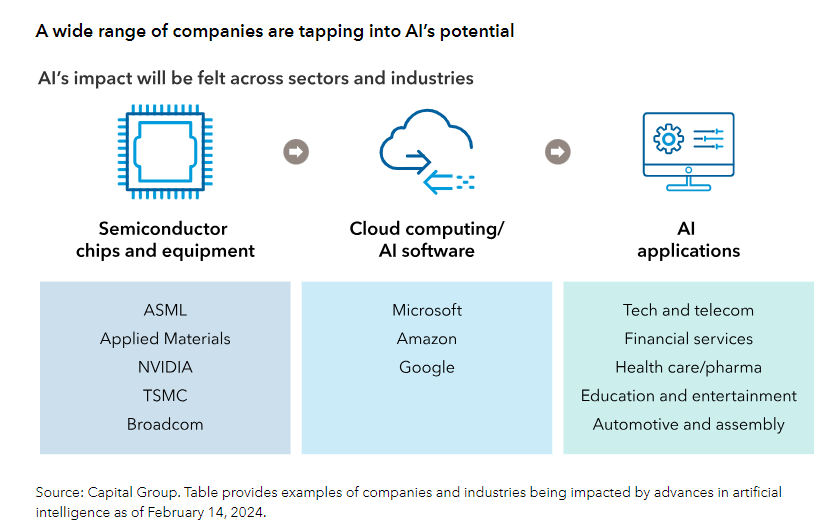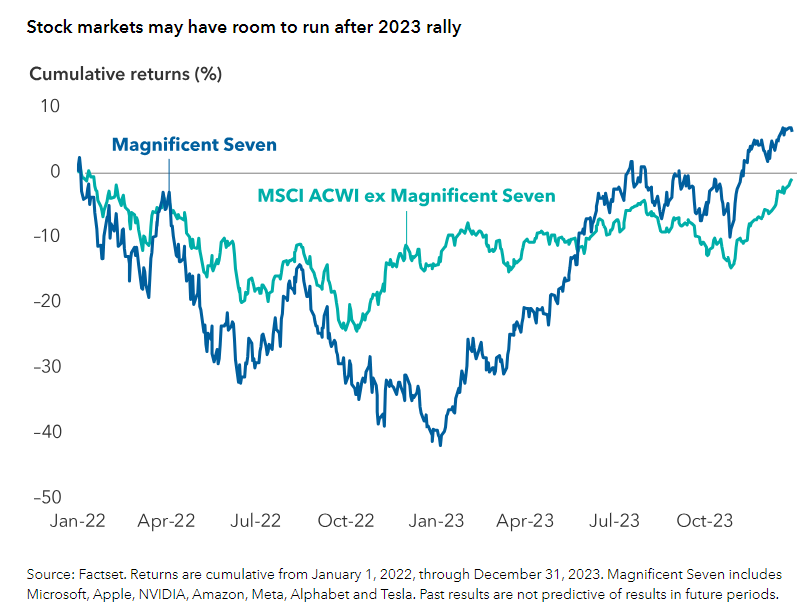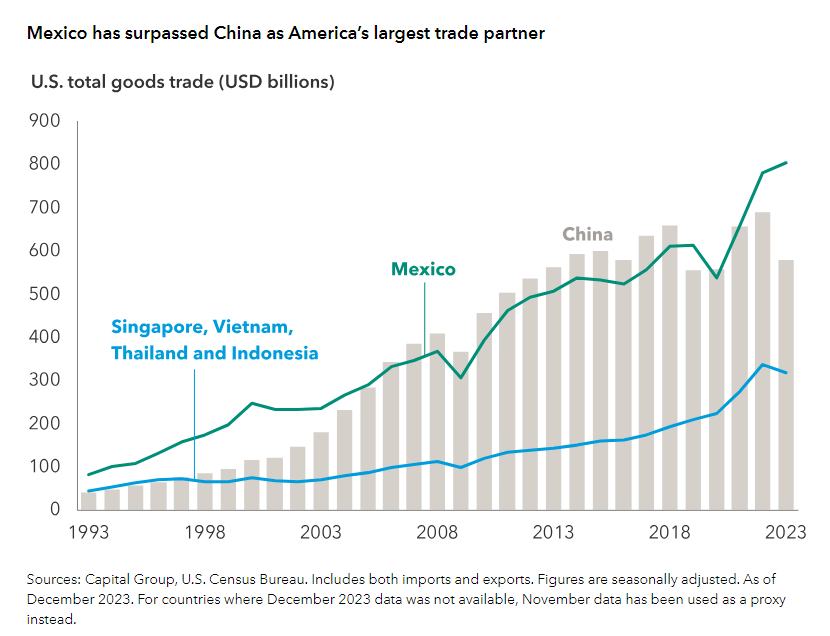Posted on February 16, 2024
A daily diet of negative news can lead even the most experienced investors to lose conviction in their long-term investment plans.
Bad news often overshadows more favorable events. Even after the U.S. avoided a recession and the inflation picture brightened in 2023, many Americans remain downbeat about the economy and markets.
With wars in Ukraine and the Mideast, simmering U.S.-China tensions and a contentious U.S. presidential campaign underway, it is understandable that investors may be anxious. Yet positive trends across technology, health care and other areas are transforming lives and driving opportunity for companies and patient investors. Here are five reasons we’re feeling confident about the future.
The U.S. may be stronger than you think
Jared Franz, U.S. economist
Investors spent 2023 bracing for a recession that never materialized. In the face of elevated inflation and rising interest rates, GDP, a measure of total economic output tracked by the U.S. Department of Commerce, expanded at a stunning 3.3% annualized rate in the fourth quarter. Indeed, the U.S. may be even stronger than you think.
First, the American consumer sector continues to flex its muscles. In January, the economy added 353,000 jobs and wages increased 4.5% year over year, a robust pace that is likely to slow. That said, continued, albeit more moderate labor and income gains can continue to support consumer spending growth. Moderating inflation should also bolster real income growth, particularly among lower income workers.
What’s more, the U.S. housing market appears to be recovering as mortgage rates ease, and there are early signs manufacturing is heating up as businesses begin restocking inventories. The U.S. federal government has committed $1.4 trillion for capital projects, including the construction of manufacturing facilities as American companies seek to diversify supply chains.
The Federal Reserve’s efforts to achieve a soft landing for the economy, bringing down inflation while maintaining growth, have thus far been successful. Inflation remains above the Fed’s 2% target, and it is unclear when the central bank may begin to lower rates. But with what it has managed thus far, the central bank may have laid the groundwork for an extended period of economic expansion.
The AI productivity boom is just beginning
Martin Romo, principal investment officer, The Investment Company of America.
The introduction of ChatGPT and other artificial intelligence (AI) tools has garnered wide attention for the technology’s potential to drive vast gains in productivity across industries, reducing costs and creating efficiencies for companies and consumers.
Of course we often overestimate technology’s impact in the short term and underestimate its impact over time. The key for investors is to distinguish between what is hype and what represents tangible investment opportunity. That said, little more than a year since ChatGPT was released it is no longer just a buzzword.
Companies in the health care, financial services and retail sectors have already begun to harness its potential to automate complex tasks, streamline workflow and accelerate technological advancements.
For example, Mastercard is using generative AI to streamline its employee recruiting process and for detection of payment fraud across its networks. Online retailer Amazon, which has long used a form of AI for its product listings and recommendations, is using AI at its Amazon Go physical locations that enables consumers to take items and pay on the Amazon app while avoiding checkout lines. In health care, AI is being adopted by hospitals and medical providers to streamline documentation and other administrative tasks, helping to reduce the number of patient visits that require physician notes and address staffing shortages.
More stocks are poised to join the market rally
Jonathan Knowles, equity portfolio manager, EuroPacific Growth Fund
Stock markets defied investor expectations last year and delivered surprisingly robust returns. The S&P 500 Index, a broad measure of U.S. stocks, soared 26.29% in 2023. The MSCI All Country World Index (ACWI) ex USA Index advanced 15.62%.
But examples of investors who think they’ve missed the market rally may want to take a deeper look. The Magnificent Seven — Apple, Meta, Microsoft, NVIDIA, Amazon, Alphabet and Tesla — accounted for an overwhelming proportion of the market’s total return in 2023. In fact, a look at returns over the past two years reveals that returns for the other 493 companies in the S&P 500 and more than 2,900 other stocks in the MSCI ACWI were generally flat. Observers can detect a similar pattern across international markets.
The brighter economic backdrop in the U.S. is providing tailwinds for corporate earnings across a broader range of companies. In fact, Wall Street analysts expect earnings growth across major markets this year. The stunning success of the Magnificent Seven may have been warranted. These companies have been responsible for creating a great deal of economic value and continue to be on the cutting edge of AI and other innovations.
But examples of innovators can be found across markets and industries that are adopting strategies to grow their businesses. In the U.S., air conditioning maker Carrier Global has seen demand for its energy efficient systems soar amid record temperatures in regions around the world. Irish insulation maker Kingspan has designed synthetic siding panels to help improve the energy efficiency of buildings. In Japan, SMC is a leader in factory automation components.
Emerging markets are emerging as global trade evolves
Jeff Garcia, equity investment analyst
Two major developments in recent years prompted governments and companies to rethink the contours of global trade.
Escalating tensions between the U.S. and China triggered tariffs and trade restrictions that adversely impacted the flow of goods around the world. This was amplified by the COVID-19 pandemic, which exposed serious vulnerabilities in supply chains as shutdowns and labor shortages led to bottlenecks and delays.
But global trade isn’t dead; it’s just transforming. To reduce the risk of overdependence on a single global supply chain, governments and companies are developing more trade relationships, many of them regional.
Sources: Capital Group, U.S. Census Bureau. Includes both imports and exports. Figures are seasonally adjusted. As of December 2023. For countries where December 2023 data was not available, November data has been used as a proxy instead.
Increasingly, American companies have turned to neighboring Mexico as an alternative trade partner. There are several reasons Mexico can be an appealing trade partner for U.S. companies. Labor costs are attractive relative to China and other major manufacturing regions. The country has ample natural resources, and its proximity to the U.S. limits logistical challenges. The relationship also helps boost the regional economy overall.
Indeed Mexico recently surpassed China as the top trade partner with the U.S. Even as China’s economy slows and its relations with the U.S. cool, infrastructure growth, improved government balance sheets and global supply chain shifts are generating opportunity across other emerging markets, including India, as well as Thailand, Indonesia, Singapore and other economies.
Ongoing breakthroughs in health care
Carl Kawaja, equity portfolio manager, The Growth Fund of America
Pharmaceutical and biotechnology companies have entered a golden age of drug discovery in the last few years, advancing therapies for a wide range of major diseases and extending and improving lives.
Perhaps the most widely talked about advancement has been the introduction of drugs developed by Novo Nordisk, Eli Lilly and others to tackle obesity. Life-threatening health problems linked to obesity include cardiovascular disease, diabetes and kidney failure, to name a few.
Several treatments have been introduced in recent years to treat and manage diabetes. In decades past, diabetics had to prick themselves several times a day to test blood sugar levels and determine whether they needed to inject themselves with insulin. Medical device companies like Abbott Laboratories and Dexcom have developed continuous glucose monitors that track blood sugar and deliver insulin through a pump. Boston biotech firm Vertex Pharmaceuticals, which developed a therapy for the treatment of cystic fibrosis, today is working on developing a cure for type 1 diabetes.
Advances in genetic sequencing have allowed innovative biopharmaceutical companies to develop gene and cell therapy cancer treatments to compete with more traditional treatments like radiation therapy. Japanese pharmaceutical Daiichi Sankyo has been developing a class of cancer therapies called antibody-drug conjugates (ADCs) genetically engineered to target cancer cells while leaving healthy cells alone.
While innovation is an essential driver of value in the health care sector, not all innovations will succeed. Investors must consider other factors, including the potential of a company’s overall pipeline of developments, the quality of its management and the potential addressable market for its therapies.
Stay focused on what matters
Distractions and discouraging news are always around us. There are the challenges we are aware of and unknown setbacks that will inevitably occur throughout the year. Bad news can drive market volatility in the near term, but company fundamentals drive long-term value. Investors who remain focused on their financial objectives will be better positioned to participate in long-term investment opportunities when they arise.
By:
Jared Franz, Economist
Jeff Garcia, Equity Investment Analyst
Carl Kawaja, Equity Portfolio Manager
February 15, 2024






Recent Comments